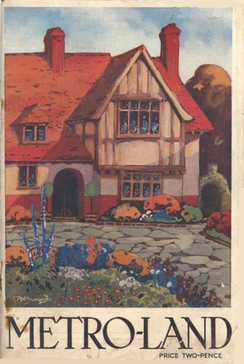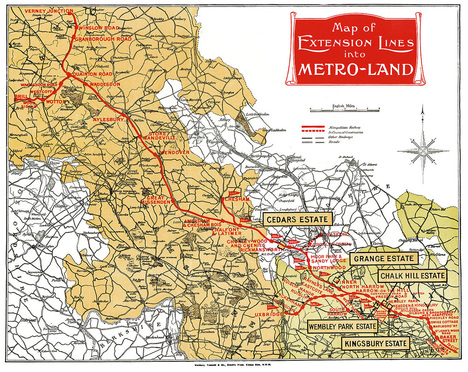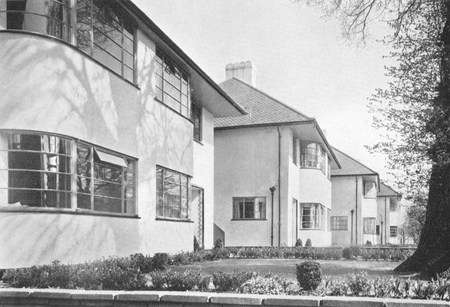|
Metro-Land is 100 years old is this year. At least the idea of Metro-Land is 100 years old, which is all Metro-Land is anyway. In 1915 an employee of the Metropolitan Railway, James Garland, came up with the concept of Metro-Land to help sell some the excess land the Met had acquired in extending its railways out from the capital into the greenery north of London. This extension linked up the capital to villages such as Wembley, Harrow, Pinner and Ruislip, and towns like Amersham and Aylesbury. The surplus land was handed over to a newly formed company, the Metropolitan Railway Country Estates Limited (MRCE) which drew up plans to create commuter villages at some of the villages along the new railway. The first estates were built at Neasden (Kingsbury Garden Village), Wembley (Wembley Garden Suburb), Pinner (Cecil Park and the Grange Estate) and Rickmansworth (the Cecil Estate). These new garden villages were largely fashioned in the Arts and Crafts style, created by architects such as Oliver Hill who designed Wembley Garden Village. Cover of the 1921 Metro-Land guidebook Image from Wikipedia The idea of Metro-Land, echoed by the tiled cottages of the garden villages, was to create a rural idyll for the commuter to escape to (via the Metropolitan Railway) after a day in the city. Posters show houses surrounded by gardens and parks where the harassed white collar worker could enjoy his free time and live in harmony with nature (at least until Monday morning). Metro-Land didn't just have the MCRE to publicise it, but also it’s own Poet Laureate. John Betjeman hymned Metro-Land praises in verses such as “Harrow-on-the-Hill” and “Middlesex”, where the poet talked of such places as Perivale, Wealdstone and Ruislip Gardens. Later on screen, his Metro-Land documentary, broadcast in 1973, went on to become a television classic. The question; what is Metro-Land? is easier to define than where is Metro-Land? As the MRCE produced Metro-Land guide famously said, it is “a country with elastic borders that each visitor can draw for himself”, an idea rather than a geographical marking. However we can shade in the map a little. Taking the aforementioned villages moving out in a line north west from Baker Street, we can see Metro-Land moving out of the capital from Neasden, taking in Wembley, Harrow, Ruislip, Pinner and then onto Amersham. Of course it didn't stick to this tidy trajectory. We can see its influence right around suburban London, taking in such places as Enfield, Barnet, Watford, Greenford, Ealing, Hillingdon, Hayes and all round the spreading ribbon developments of the capital. As another quote had it, “Metroland…the great suburban empire of the underground”. Map of Metro-Land from in 1924 guidebook. Image from Wikipedia Being influenced by the Garden Suburb movement and due to its innate Englishness, the default architectural style of Metro-Land was nostalgic, a mixture of Mock Tudor and Elizabethan, nicknamed Tudorbeathen. However outbreaks of Modernism did occur in this realm of wistfulness. Charles Holden’s London Underground stations are the most prominent example. His ‘Sudbury Box’ first appeared at Sudbury Town in 1931, and its pared down brick and glass minimalism set a template for stations throughout suburbia. Another widespread but lesser known example of the Scandinavian modernism being built in Metro-Land were the schools of Curtis and Burchett for Middlesex County Council. The duo designed and built a swathe of schools throughout the county, often with their signature Dudok influenced central tower. The pair also built a number of other municipal facilities such as clinics, libraries and houses. There was also room among the mock timber for the white walled, flat roofed house. Welch, Lander and Day built large number of Deco influenced ‘Sun Trap’ houses throughout the 1930’s, as well as more robust looking brick dwellings in Hendon and on the Hanger Hill estate. The darlings of the international style in Britain were of course the partnership of Connell, Ward and Lucas. Their signature house ‘High and Over’ nestles in the green hills of Amersham on the Metropolitan Line, built in a Y plan for Professor Bernard Ashmole.. Perhaps even more cutting edge was their design for a whole estate in Pinner, of which only three houses were completed, 97, 99 & 101 Park Avenue. The art deco cinema was also in its golden age during the rise of Metro-Land, and many great examples still exist such as the Rayners Lane Grosvenor by local architect FE Bromige. Sun Trap Houses, St Margaret's Estate, Edgware by Welch and Lander Image from WGC Books Much has changed in Metro-Land in the post war period. Just as Metro-Land had itself swallowed up tiny villages, the ever growing metropolis submerged the arcadian ideal sold on those posters from the MCRE. Now the former villages and Garden suburbs of Wembley, Pinner and Harrow have become part of the endless exterior sprawl of London, losing some of their unique character. And of course the growth of modernism in Metro-Land didn't stop either, it became part of the state sanctioned post war redevelopment. The harsher Brutalist style buildings of the the 50’s, 60’s and 70’s did not proliferate as much as in Central and East London, but there are some good examples of buildings by Erno Goldfinger, Owen Luder and the Smithsons in this area. Palace of Arts, British Empire Exhibition, Wembley 1924
Image from NZ Design History As redevelopment rumbles ever onward, many monuments to modernism in Metro-Land are disappearing, in the last year a number of buildings have been demolished, such as the Palace of Industry at Wembley and the Electricity Showrooms in Willesden.That of course is why we started this website, to document these wonderful and half forgotten buildings before they disappear through accident or design. This year we will be celebrating the great diversity of styles and architects that built modernist Metro-Land, from Holden’s tube stations and Wallis, Gilbert and Partners factories, to the individual Art Deco houses and on into the post war period of concrete and glass. We hope you will enjoy us in raising a toast to that country with elastic borders!
1 Comment
|
Archives
May 2024
Categories |




 RSS Feed
RSS Feed